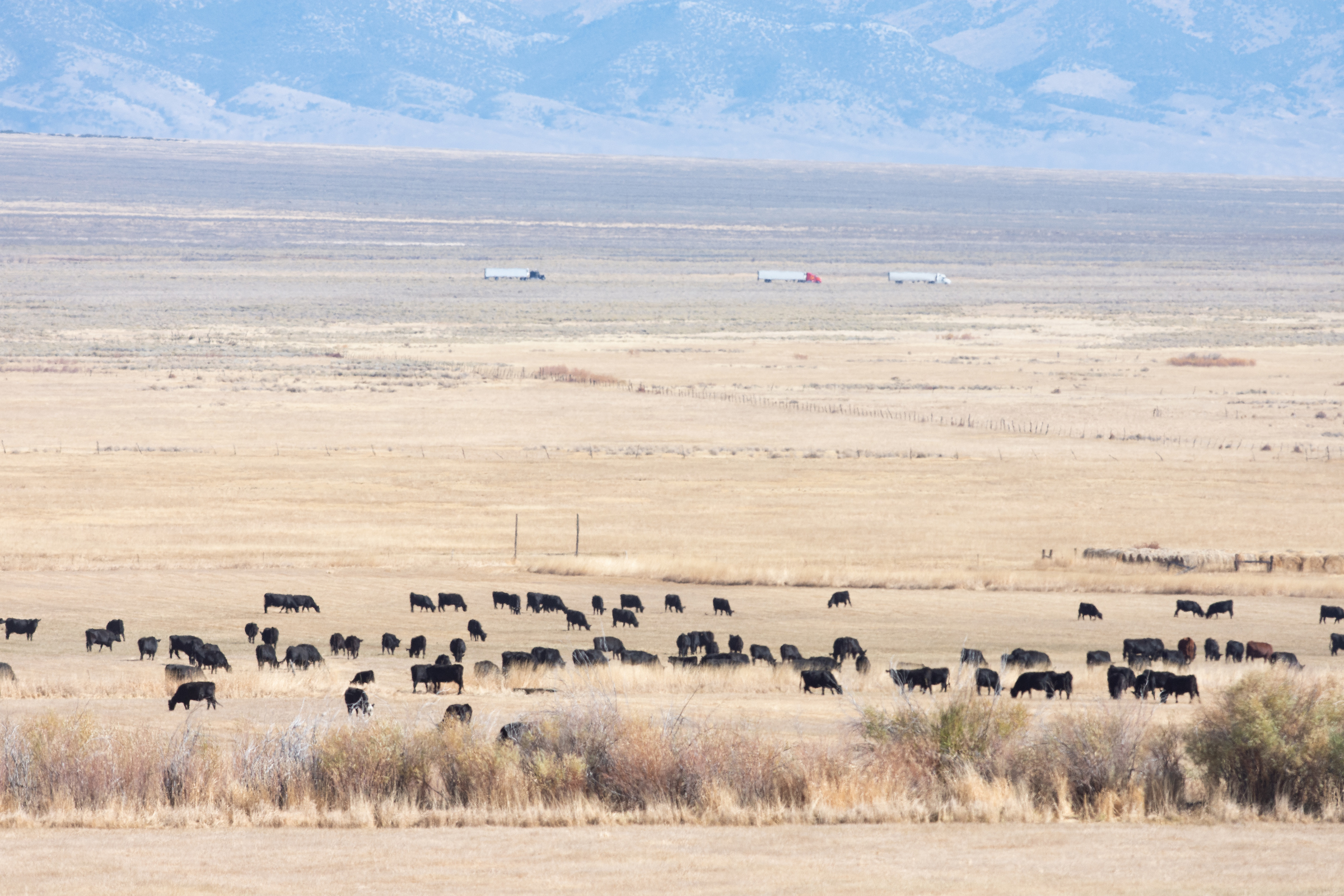Will climate change and technological progress end Nevada's beef industry?

According to Bloomberg, the CEO of Danish Crown, Europe’s top meat processor, believes beef “will be a luxury product that we eat when we want to treat ourselves” due to beef’s climate impact. If this is true, how will this impact Nevada’s cattle-centric agricultural sector?
Before we answer that question, it’s important to acknowledge that “if this is true'' is carrying a lot of weight. If the Flying Spaghetti Monster is real and the United Church of Bacon is the one true church, all things are, perhaps, possible at Zombo.com — but if turn of the century atheist meme churches are stale parodies, perhaps the only thing possible at the most useless site on the internet is nostalgia for a simpler, less self-serious internet. Similarly, there may be a limit to how seriously we should take pronouncements about the impending scarcity of beef from the CEO of a meat processing company that not only focuses more on pork, but is facing a lawsuit for allegedly making misleading claims about how comparatively carbon-friendly pork production is.
Even so, the stakes for Nevada’s agricultural sector are high.
According to the most recent US Department of Agriculture’s Census of Agriculture, cattle, calves, and the hay that feeds them accounted for over 70 percent of Nevada’s $665 million worth of agricultural output in 2017. This shouldn’t be particularly surprising — grazing animal husbandry has been a reliable method of producing food on lands that wouldn’t otherwise support crop agriculture for thousands of years and Nevada’s lands are some of the least suited for crop agriculture in the nation. Where Nevada’s lands can be irrigated (at least for a while), the soil is frequently too saline to efficiently produce food crops, so saline-resistant forage grasses are planted instead. Even alfalfa, which grows best in alkaline soils like Nevada’s, is only moderately salt tolerant.
Put it all together and Nevada’s lands are far better at feeding food than they are at feeding people. If raising ruminants becomes unpopular for environmental, economical, or ethical reasons, there isn’t much else Nevadans can offer the world’s dinner tables.
Unfortunately, cattle have a problem — they stink.
As anyone who’s eaten too much cabbage during dinner can attest, digesting vegetable matter can produce a lot of methane, a rather potent greenhouse gas. This is especially true when you’re eating hard to digest grasses with high amounts of cellulose (an organic compound humans can’t digest) and process the resulting cud through four(-ish) stomachs. Consequently, each cow belches about 220 pounds of methane — which is why cattle are not only the top agricultural source of greenhouse gases worldwide, but also produce more greenhouse gases per gram of protein than any other widely available protein source.
The good news is methane, unlike carbon dioxide, oxidizes quickly in the atmosphere. According to the Environmental Protection Agency’s Overview of Greenhouse Gases, methane breaks down within 12 years. Additionally, as the CLEAR Center at the University of California, Davis takes pains to point out, cattle are simply converting existing biomass into methane, which then oxidizes in the atmosphere and is eventually respirated by future plant life. Cattle, in other words, are carbon-neutral — or, at least, more carbon-neutral than my Mazda hatchback, which runs on refined fossilized carbon deposits.
The bad news, however, is two-fold. First, before methane oxidizes, it’s a 25 times more efficient greenhouse gas, at equivalent volumes, than carbon dioxide. Second, methane oxidizes into carbon dioxide and water vapor, two considerably longer lasting greenhouse gases.
This is part of the reason why the CEO of the European Union’s largest meat processor is, pardon the expression, not bullish on the future of beef consumption (well, that and nakedly obvious self-interest as a continent-leading pork processor). The European Union has been trying to tackle carbon-caused climate change through a variety of policies, including through an Emissions Trading System, which caps total EU emissions and auctions off a fixed number of allowances to power plants, factories, and the transportation sector, and a Carbon Border Adjustment Mechanism, which taxes imports according to the amount of emissions produced during their manufacture. As long as these policies remain in place, it will consequently become increasingly difficult and expensive to raise or import beef into the European Union.
Luckily, at least if you’re one of Nevada’s cattle ranchers, political will for meaningful carbon reduction is virtually nonexistent in the United States. Though a supermajority of Americans polled by the Washington Post and the Kaiser Family Foundation claim climate change is either a major problem or a crisis, a majority of Americans aren’t even willing to accept a $2 monthly tax on residential electrical bills to do something about it — this is what economists would call a textbook difference between “stated preferences” and “revealed preferences.”
For now, in other words, the vast majority of Americans would love somebody to do something about climate change, provided absolutely anybody else pays for it and doing so doesn’t meaningfully affect our lifestyles or consumption habits at all. Consequently, the chances that the United States will adopt a European Union-style cap-and-trade system or any other carbon tax is, regardless of the political party in charge, utterly fanciful. We can’t even talk ourselves out of buying new gas stoves (don’t feel bad, I’m not giving up mine, either).
Still, there remains some bad news on the horizon for Nevada’s beef producers — and good news for those of us who would like to do something about climate change without actually meaningfully inconveniencing ourselves at all:
Plant-based meat substitutes are here and they’re very similar to the real thing now, actually.
J. Kenji López-Alt is an almost insufferably curious chef who, among other exploits, once cooked over 100 different batches of chocolate chip cookies (1,536 cookies in all) to identify which ingredients, in what ratios, cooked according to which techniques produced the optimal chocolate chip cookie. Applying that same level of over-the-top experimentally-driven curiosity to plant-based meat substitutes produced by Beyond Meat and Impossible Foods, he came to a conclusion: If properly cooked, they’re actually really good and are perfectly serviceable meat substitutes in many dishes.
This means, for the sort of person who might find meat consumption ethically questionable for whatever reason (utilitarianism is just morally motivated reasoning with extra steps) but doesn’t want to give up on the taste and texture of meat, there are acceptable plant-based substitutes on the market which Nevadans can buy today. Though these substitutes won’t substitute a steak anytime soon, they’re a serviceable substitute in many applications which would normally call for a hamburger. Given enough time, uptake, and incremental improvement of the product, plant-based substitutes are going to cut into the bottom end of the beef market.
On the brighter side for Nevada’s cattle ranchers, however... Despite the clearly obvious increase in quality in plant-based meat substitutes, market demand isn't quite there. Additionally, the top end of the market is probably safe, at least for now. The ability to artificially cultivate anything steak-like in a lab at an acceptable cost using current production methods remains an expensive pipe dream — meat cells remain far more efficient to produce as part of a living thing than in a medical-grade lab. Though there are likely to be future breakthroughs in lab-grown meat production, it’ll probably take multiple paradigm shifts — fundamental and radical changes in how we produce lab-grown meat cells, in other words — to get from where we are today to something which you can afford to buy in a grocery store.
One thing Silicon Valley venture capitalists frequently miss when they throw money at moonshots like lab-grown meat is an appreciation of their industry’s own history. Though Charles Babbage’s gear-driven Analytical Engine, which would have been a Victorian-era general purpose mechanical computer if he found someone willing to fund its construction, was an interesting idea, it’s probably impossible to miniaturize sufficiently to function as a handheld calculator. Similarly, though pre-transistor electronic computers like Z3, Colossus, and ENIAC are impressive, given the manufacturing constraints and technology of the time, throwing money at ever-smaller vacuum tubes would have been a colossal waste of time and resources. Only after the invention of the transistor, and the subsequent invention of the integrated circuit, was it possible to miniaturize computing hardware enough to achieve Moore’s Law and experience the regular breakthroughs in affordable computing we take for granted today.
That’s not to say people didn’t learn a lot from those early abortive attempts to manufacture general purpose computers. They did, and the legacy of Ada Lovelace, the world’s first computer programmer, remains felt to this very day. The story of Alan Turing’s analytical brilliance during World War 2 — and his subsequent chemical castration for homosexuality — are Hollywood fodder now, all while his theories of computing are routinely taught in computer science programs throughout the world. Similarly, attempts to produce large scale lab-grown meat may produce similar insights — provided we don’t overcommit to our current processes, economically unsustainable as they presently are.
Then again, if plant-based meat keeps getting better, it might not matter whether we can download and print a steak cell-by-cell or not. Regardless, Nevada’s cattle ranchers are undoubtedly happy we’re not quite there yet — at least as long as we continue to avoid plant-based hamburger substitutes at the drive-thru.
David Colborne was active in the Libertarian Party for two decades. During that time, he blogged intermittently on his personal blog, ran for office twice as a Libertarian candidate, and served on the executive committee for his state and county Libertarian Party chapters. He is now an IT manager, a registered non-partisan voter, and the father of two sons. You can follow him on Twitter @DavidColborne or email him at [email protected].
